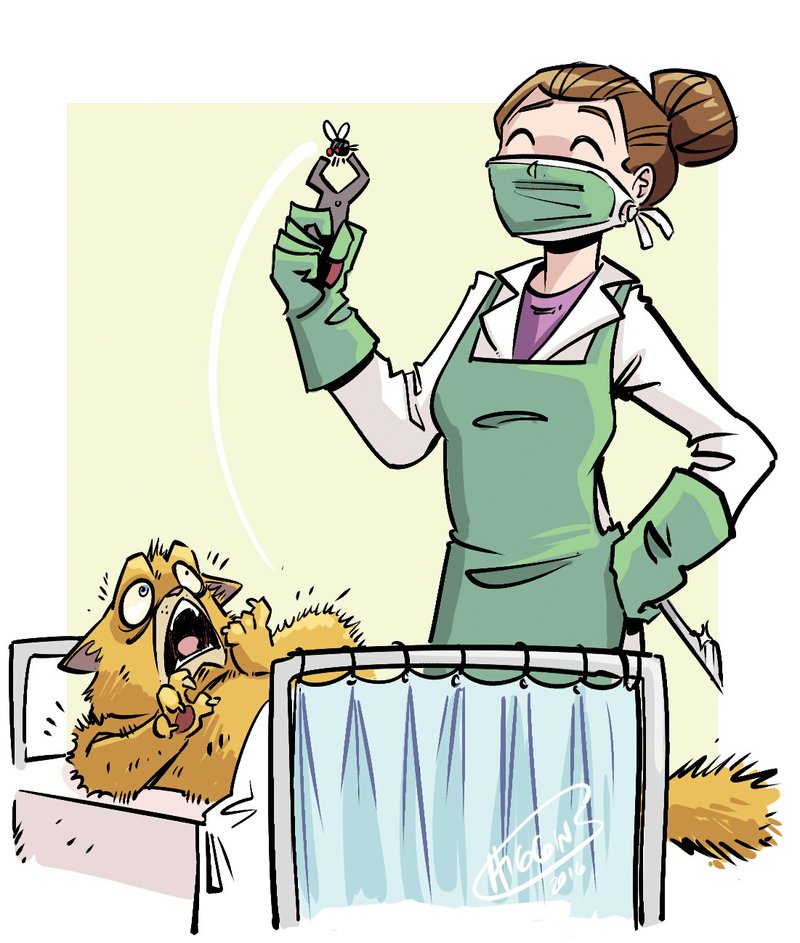We had a stray cat adopt us recently. When cleaning her up, we noticed she had a sore place on her skin that she had been biting and licking. We washed it and saw right away there was something weird. It was a bump with a hole on it and it looked like there was something in the hole under the skin. Long story short, we took the cat to the veterinarian and he pulled a bug out of her skin. He said it was a cuterebra and we were lucky we didn't try to pull it out ourselves. The cat is fine and the sore is healing. Can you tell us more about the bug and warn people about it?
A cuterebra is a large bot fly whose larva can infest the bodies of small mammals, where the larva develops into an adult fly. Dogs and cats aren't the cuterebra's hosts of choice, and become infested only under certain conditions.
Most pet owners can rest assured that the not-so-cute cuterebra doesn't leap upon random passing pets, says veterinarian Deborah Waggener of the St. Francis Animal Hospital in Springdale. Waggener, who has been a vet for 20 years, says she has seen a number of cases of bot fly infestation in cats and dogs. She says, however, that the chances of a dog or cat picking up a cuterebra larva "kind of depends on how well people are taking care of their animals."
She says that a pet with a draining sore or wound could attract a bot fly, which might lay an egg in the wound; the egg would hatch into a larva or baby bot fly. Neither the fly nor a larva will burrow under the animal's skin, but should only enter an existing opening.
"There has to be something that actually attracts the flies," Waggener says.
That's where pet care comes into the picture. Alert pet owners usually clean wounds and wipe away any secretions, which means there's nothing to draw a bot fly's attention. Secretions -- whether thin, watery drainage or thicker bacteria-laden pus -- give the larva something to feed upon. No secretions mean no food.
If you notice something weeping and you clean it off, you've solved the problem, Waggener says.
Cuterebra larvae also have been known to infest an animal's nose or ears. A video that's been popping up online shows a veterinarian removing a large cuterebra from a kitten's nose. What likely happened is that the kitten's nose was running, or secreting, and the secretions captured the attention of a bot fly.
Because of the bot fly's life cycle, most cases of cuterebra infestation in Arkansas are reported in July, August and September, Waggener says.
Infestations are more likely in rural areas, but also can occur in urban pets if the animals don't receive much attention from humans. A person petting a cat or dog might feel a bump or notice a hole in the skin, particularly if the animal has been licking or biting at the infested area.
The sight of a bristly cuterebra nestled in a hole in an animal's skin can be alarming, but pet owners shouldn't try to remove the thing themselves. They need to get the pet to a vet as soon as possible, Waggener says.
The larva needs to be extracted in one piece. Breaking the larva can prompt a fatal allergic reaction in the pet.
To remove the larva intact, the vet will make an incision to enlarge the hole, which exists to allow the cuterebra to breathe. A cuterebra's size depends on its age. A newly hatched larva might be a quarter-inch or less in length while a more mature one could be as long as 1 1/2 inches.
After the larva is removed, the pet will recover. But if a larva is allowed to stay in the animal and grow into a fly, problems arise.
"Depending on where the fly is, a pet could end up losing its life," Waggener says. "If it's in the nose and gets big enough to hatch into a fly, then it could eventually get into the animal's brain and kill it."
Waggener's advice to owners of dogs and cats is to pet them often and pay attention to any skin anomalies.
"If you're petting them all the time," she says, "chances are you'd notice something pretty quickly."
Family on 08/17/2016
